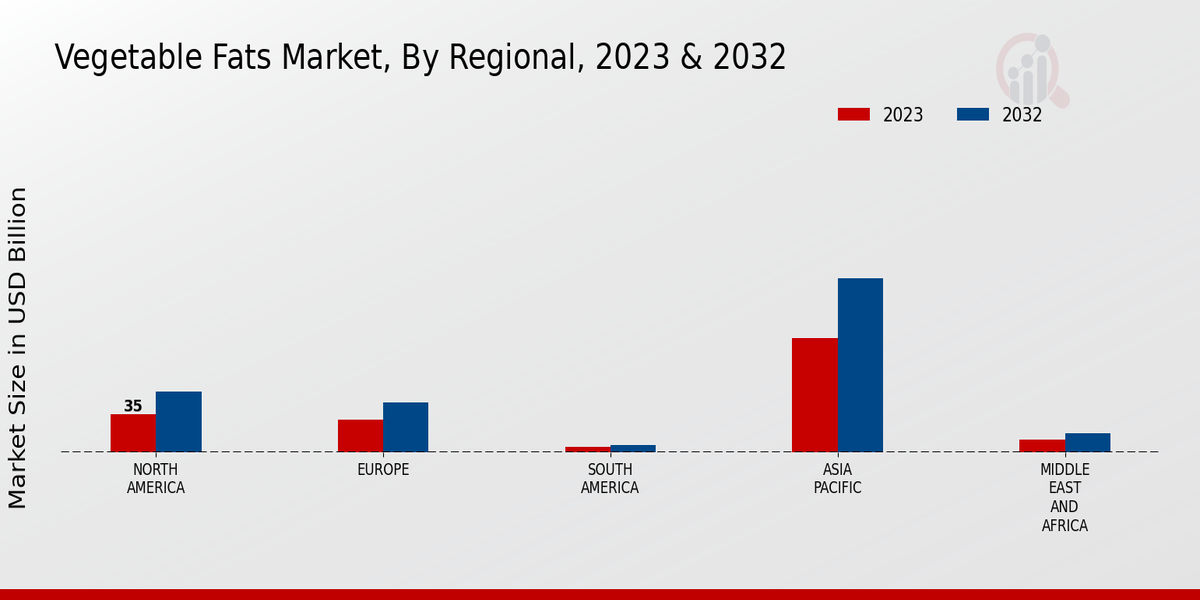Market Growth Projections
The Global Vegetable Fats Market Industry is poised for substantial growth, with projections indicating a market value of 151.5 USD Billion in 2024 and an anticipated increase to 233.8 USD Billion by 2035. This growth trajectory suggests a robust compound annual growth rate (CAGR) of 4.02% from 2025 to 2035. Such figures underscore the increasing relevance of vegetable fats in various applications, driven by consumer trends towards health, sustainability, and plant-based diets. The market's expansion reflects broader shifts in dietary preferences and industry practices, positioning vegetable fats as a key component in the global food landscape.
Rising Health Consciousness
The Global Vegetable Fats Market Industry is experiencing a notable shift driven by increasing health consciousness among consumers. As individuals become more aware of the health implications of dietary fats, there is a growing preference for vegetable fats over animal fats. This trend is particularly evident in regions where heart health and obesity are major concerns. For instance, the demand for plant-based oils, such as olive and canola oil, is on the rise, reflecting a broader movement towards healthier eating habits. This shift is expected to contribute to the market's growth, with projections indicating a market value of 151.5 USD Billion in 2024.
Sustainable Sourcing Practices
Sustainability has emerged as a critical driver in the Global Vegetable Fats Market Industry. Consumers and manufacturers alike are increasingly prioritizing sustainable sourcing practices, which include the cultivation of oilseeds through environmentally friendly methods. This trend is particularly pronounced in the production of palm oil, where sustainable certifications are gaining traction. Companies that adopt these practices not only enhance their brand image but also cater to a growing segment of eco-conscious consumers. As a result, the market is likely to witness a surge in demand for sustainably sourced vegetable fats, further bolstering its projected growth to 233.8 USD Billion by 2035.
Diverse Applications Across Industries
The versatility of vegetable fats is a significant driver for the Global Vegetable Fats Market Industry. These fats are utilized across various sectors, including food and beverage, cosmetics, and pharmaceuticals. In the food industry, vegetable fats serve as essential ingredients in margarine, baked goods, and snack foods, enhancing texture and flavor. Additionally, the cosmetic industry employs vegetable fats in formulations for moisturizers and creams due to their emollient properties. This diverse applicability not only supports steady demand but also positions the market for sustained growth, with a projected CAGR of 4.02% from 2025 to 2035.
Growing Demand for Plant-Based Products
The surge in demand for plant-based products is a pivotal driver for the Global Vegetable Fats Market Industry. As more consumers adopt vegetarian and vegan lifestyles, the need for plant-derived fats has escalated. This trend is reflected in the food sector, where plant-based alternatives to dairy and meat are gaining popularity. For instance, the rise of plant-based dairy substitutes, such as almond and soy milk, relies heavily on vegetable fats for texture and flavor. This growing consumer preference for plant-based options is expected to significantly influence market dynamics, contributing to the anticipated growth trajectory.
Technological Advancements in Processing
Technological innovations in the processing of vegetable fats are reshaping the Global Vegetable Fats Market Industry. Advances in extraction and refining techniques have improved the quality and yield of vegetable oils, making them more appealing to manufacturers. For example, cold-press extraction methods preserve the nutritional integrity of oils, catering to health-conscious consumers. Furthermore, innovations in hydrogenation processes have led to the development of trans-fat-free options, aligning with dietary guidelines. These advancements not only enhance product offerings but also drive market growth, as consumers increasingly seek high-quality, health-oriented vegetable fats.













